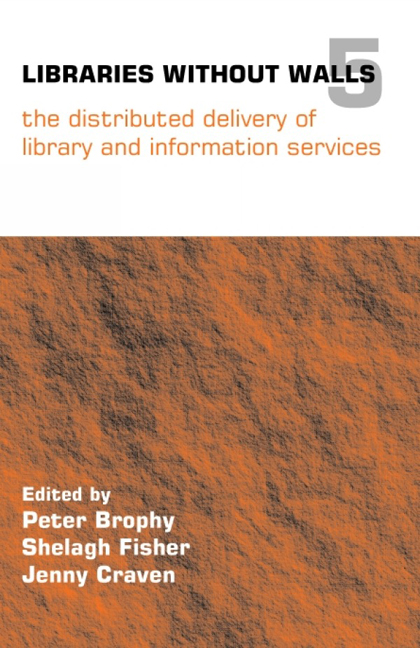Book contents
- Frontmatter
- Contents
- Contributors
- 1 Introduction
- 2 Keynote paper: beyond the mainstream of library services
- THEME 1 THE INTEGRATION OF LIBRARY SERVICES AND VIRTUAL LEARNING ENVIRONMENTS
- 3 Staff without walls: developing library and information staff for e-learning
- 4 Supporting information-based networks in higher education
- 5 Library services and virtual learning: the DEViL project
- 6 Virtual learning and teaching resources: the library as a collaborator
- 7 Virtual learning environments and Greek academic libraries
- THEME 2 THE RELATIONSHIP BETWEEN USER NEEDS, INFORMATION SKILLS AND INFORMATION LITERACIES
- THEME 3 USABILITY AND ACCESSIBILITY OF DIGITAL LIBRARY SERVICES
- THEME 4 DESIGNING THE INFORMATION ENVIRONMENT: NATIONAL AND INSTITUTIONAL PERSPECTIVES
- THEME 5 THE CREATION OF DIGITAL RESOURCES BY USER COMMUNITIES
- Index
- Miscellaneous Endmatter
- Miscellaneous Endmatter
- misc-endmatter
- Miscellaneous Endmatter
6 - Virtual learning and teaching resources: the library as a collaborator
from THEME 1 - THE INTEGRATION OF LIBRARY SERVICES AND VIRTUAL LEARNING ENVIRONMENTS
Published online by Cambridge University Press: 08 June 2018
- Frontmatter
- Contents
- Contributors
- 1 Introduction
- 2 Keynote paper: beyond the mainstream of library services
- THEME 1 THE INTEGRATION OF LIBRARY SERVICES AND VIRTUAL LEARNING ENVIRONMENTS
- 3 Staff without walls: developing library and information staff for e-learning
- 4 Supporting information-based networks in higher education
- 5 Library services and virtual learning: the DEViL project
- 6 Virtual learning and teaching resources: the library as a collaborator
- 7 Virtual learning environments and Greek academic libraries
- THEME 2 THE RELATIONSHIP BETWEEN USER NEEDS, INFORMATION SKILLS AND INFORMATION LITERACIES
- THEME 3 USABILITY AND ACCESSIBILITY OF DIGITAL LIBRARY SERVICES
- THEME 4 DESIGNING THE INFORMATION ENVIRONMENT: NATIONAL AND INSTITUTIONAL PERSPECTIVES
- THEME 5 THE CREATION OF DIGITAL RESOURCES BY USER COMMUNITIES
- Index
- Miscellaneous Endmatter
- Miscellaneous Endmatter
- misc-endmatter
- Miscellaneous Endmatter
Summary
Introduction
Learning, teaching and research methods are undergoing rapid and significant changes, which are affecting everybody who reads or writes. Electronic resources are increasingly selected as an information source, and research results are disseminated via information networks. Electronic media also bring about a transformation in how librarians think about their jobs, about information users, and about the whole communication process that they are a part of.
Digital publishing has critical implications for teaching and learning, and calls for a fresh look being taken at instructional strategies and the accessibility of information. Electronic resources and digital libraries have the capacity and promise to affect education significantly, and have an opportunity to create a new environment for teaching and learning (Dowler, 1997). This paper will reflect on environmental changes that affect libraries and identify activities that generate added value for teaching and learning, and which Tampere University library has adopted.
Changes in the work environment
Trends in publishing
Anything that happens in the publishing field affects libraries and there are many changes in scientific information and publishing structures. In some fields electronic publishing has surpassed its printed counterpart, so that many important materials do not exist in conventional formats any longer.
Libraries have an important proactive role in developing and using new publishing channels, and also in assisting faculty and students to make use of those channels. Libraries remain relevant only as long as they supply collections and services that meet the changing needs of their users in the classroom and at the desktop.
Characteristics of university libraries’ clientele
The user demographics of university libraries are getting more diverse. Faculty and students are increasingly wide-ranging in their interests, background and skills, and display an increasingly varying set of information needs and expectations. Furthermore, new fields of study and the emergence of virtual universities place additional demands on libraries.
Learning and teaching strategies
New views about learning and teaching with more emphasis on cognition are emerging and the problem-based method is becoming more prevalent. This method emphasizes active learning and expects students to become self-directed learners, assuming more responsibility for information gathering through exploring information resources and networks. Electronic resources offer innovative approaches to teaching, and make virtual, web-based teaching and learning possible (Poikela, 2001).
Information
- Type
- Chapter
- Information
- Libraries Without Walls 5The Distributed Delivery of Library and Information Services, pp. 56 - 65Publisher: FacetPrint publication year: 2004
Accessibility standard: Unknown
Why this information is here
This section outlines the accessibility features of this content - including support for screen readers, full keyboard navigation and high-contrast display options. This may not be relevant for you.Accessibility Information
- 2
- Cited by
